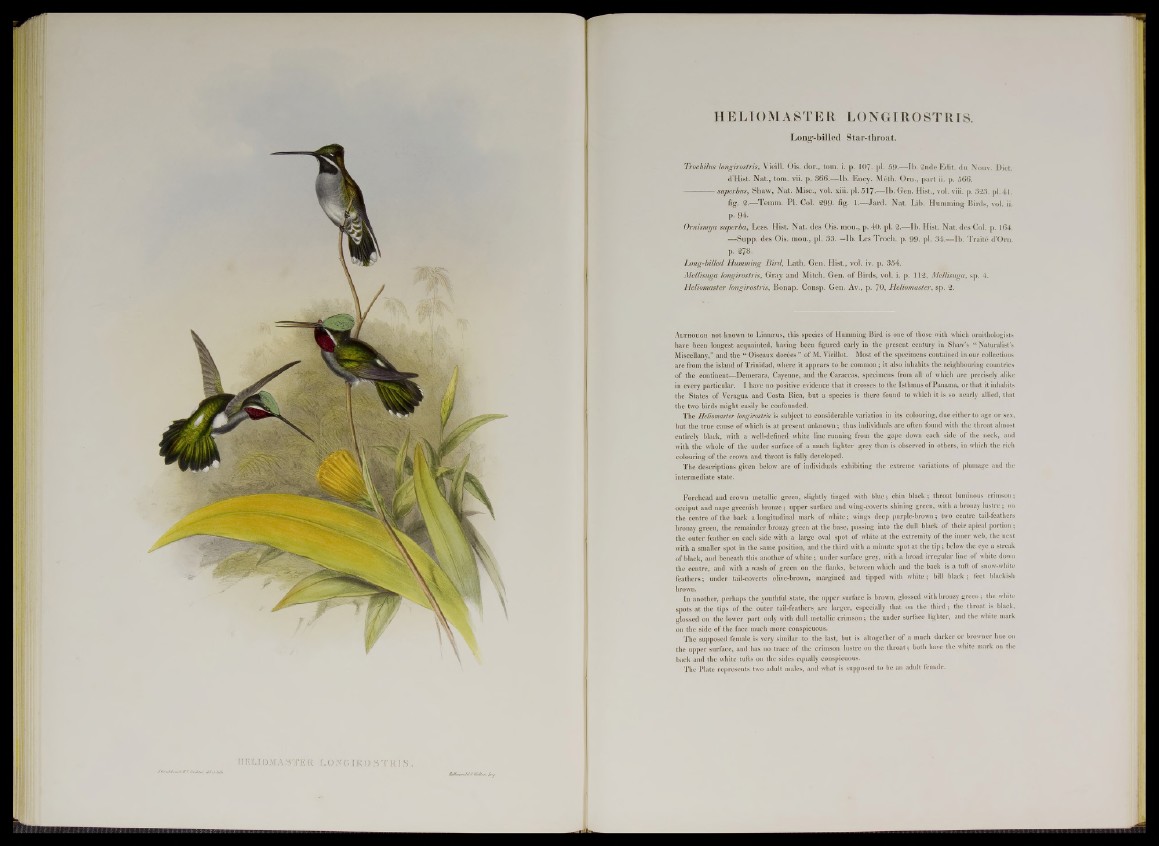
H ELI OM ASTER LONGIROSTRIS .
Long-billed Star-throat.
Trochilus ¿ongirostris, Vieill. Ois. dor., tom. i. p. 107- pi. 59-— lb . 2n d eE d it. du Nouv. Diet.
d’Hist. N a t., tom. vii. p. 366.—lb . Ency. Méth. Orn ., p a rt ii. p. 566.
-------------superbus, Shaw, Nat. Misc., vol. xiii. pi. 517-— lb . Gen. Hist., vol. viii. p. 323. pi. 41.
fig. 2.— Temm. PI. Col. 299. fig. 1.— J a rd . Nat. Lib. Humming Birds, vol. ii.
p. 94.
Ornismya superba, Less. Hist. N at. des Ois. mou., p. 40. pl. 2.—lb . Hist. Nat. des Col. p. 164.
— Supp. des Ois. mou., pl. 33. —Ib. Les Troch. p. 99. pl. 34.—Ib. Traité d’Orn.
p. 278.
Long-billed Humming B ird , Lath. Gen. Hist., vol. iv. p. 354.
Mellisuga longirostris, Gray and Mitch. Gen. o f Birds, vol. i. p. 1 12, Mellisuga, sp. 4.
Heliomaster longirostris, Bonap. Consp. Gen. Av., p. 70, Heliomaster, sp. 2.
Although not known to Linnaeus, this species of Humming Bird is one of those with which ornithologists
have been longest acquainted, having been figured early in the present century in Shaw’s “ Naturalist’s
Miscellany,” and the “ Oiseaux dorees ” of M. Vieillot. Most of the specimens contained in our collections
are from the island of Trinidad, where it appears to be common; it also inhabits the neighbouring countries
of the continent—Demerara, Cayenne, and the Caraccas, specimens from all of which are precisely alike
in every particular. I have no positive evidence that it crosses to the Isthmus of Panama, or that it inhabits
the States of Veragua and Costa Rica, but a species is there found to which it is so nearly allied, that
the two birds might easily be confounded.
The Heliomaster longirostris is subject to considerable variation in its colouring, due either to age or sex,
but the true cause of which is at present unknown; thus individuals are often found with the throat almost
entirely black, with a well-defined white line running from the gape down each side of the neck, and
with the whole of the under surface of a much lighter grey than is observed in others, in which the rich
colouring of the crown and throat is fully developed.
The descriptions given below are of individuals exhibiting the extreme variations of plumage and the
intermediate state.
Forehead and crown metallic green, slightly tinged with blue; chin black; throat luminous crimson;
occiput and nape greenish bronze; upper surface and wing-coverts shining green, with a bronzy lustre ; on
the centre of the back a longitudinal mark of white; wings deep purple-brown; two centre tail-feathers
bronzy green, the remainder bronzy green at the base, passing into the dull black of their apical portion ;
the outer feather on each side with a large oval spot of white at the extremity of the inner web, the next
with a smaller spot in the same position, and the third with a minute spot at the tip ; below the eye a streak
of black, and beneath this another of white; under surface grey, with a broad irregular liue of white down
the centre, and with a wash of green on the flanks, between which and the back is a tuft of snow-white
feathers; under tail-coverts olive-brown, margined and tipped with white; bill black ; feet blackish
brown.
In another, perhaps the youthful state, the upper surface is brown, glossed with bronzy green; the white
spots at the tips of the outer tail-feathers are larger, especially that on the th ird ; the throat is black,
glossed on the lower part only with dull metallic crimson; the under surface lighter, and the white mark
on the side of the face much more conspicuous.
The supposed female is very similar to the last, but is altogether of a much darker or browner hue on
the upper surface, and has no trace of the crimson lustre on the throat; both have the white mark on the
back and the white tufts on the sides equally conspicuous.
The Plate represents two adult males, and what is supposed to be an adult female.